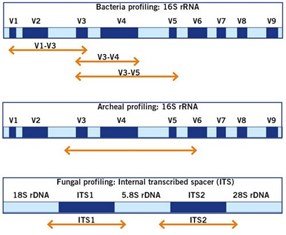Overview - What is microbial sequencing?
Microbial profiling using 16S ribosomal RNA (rRNA) sequencing is a common method for studying bacterial phylogeny and taxonomy. The 16S rRNA gene is the most established genetic marker used for bacterial identification and classification, mainly because it consists of both highly conserved and hypervariable regions. The conserved regions can serve as universal primer binding sites for the amplification of the whole gene or fragments of the gene, whereas the hypervariable regions contain species-specific sequences that can discriminate between different bacteria and archaea.
Similarly, the internal transcribed spacer (ITS) region is utilised for the taxonomic profiling of the fungi.
With the sequencing data of the 16S rRNA gene and ITS region available in public databases, rDNA amplification and sequencing can semi-quantitatively describe bacteria, archaea and fungi present in complex biological samples. This method is considered by many as the gold standard for analysis of whole bacterial, archaeal and fungal communities and their members. rRNA gene sequencing can be used to process environmental and clinical samples and can serve various purposes from food quality assurance to gut microbiota research.

Applications - What are the advantages of microbial rRNA gene sequencing?
Determining the DNA sequence of the 16S rRNA gene and ITS region is a preferred method for studying the taxonomy of microbiome and microbiota members as it can be used to:
- Characterise non-cultivable bacteria
- Profile hundreds of microorganisms from a single Analysis
- Semi-quantify the relative abundance of microbiome members
- Study complex microbiomes
- Provide faster and more accurate classification than traditional identification methods like cloning and culturing
- Identify low-abundance bacteria
- Multiplex microbial samples, providing more cost-effective microbiome characterisation
Workflow - Methods & technologies for microbial sequencing of rRNA amplicons
16S rRNA and ITS region gene sequencing is a type of amplicon sequencing. More specifically, all or parts of the gene are amplified with universal primers specific to the conserved regions. The primer sets are designed to capture the widest range of different microorganisms possible. The amplified fragments are then analysed via next-generation sequencing (NGS).
The resulting reads are clustered together with other related sequences at a pre-defined level of identity and then quantified. These clusters of similar sequencing reads are referred to as operational taxonomic units (OTUs). OTU counts are summarised in a table of relative abundancies for each bacteria in each sample and the data are used for downstream processing. A level of 97% sequence identity is often chosen as representative of a species and 95% for a genus. Microbial identification is accomplished by comparison to sequences in reference databases.
rRNA amplicon sequencing versus metagenomics
Three methods are commonly used for taxonomic classification of organisms that are found in microbiomes. Sanger sequencing of the rRNA genes is the traditional method for characterisation of microbial communities. Another common targeted approach uses NGS to determine the sequence of ribosomal genes. The third method, metagenomic sequencing, involves total DNA isolation from the starting material and subsequent reassembly of NGS-derived sequencing reads into the microbial genomes of origin.
All approaches have advantages and disadvantages. Whereas rRNA can exhibit biases by amplifying species unequally, metagenomic sequencing could be less efficient at detecting rare species in a microbial community. rRNA gene data can also capture a broader range of microbiome diversity, but with a lower sensitivity and resolution compared to metagenomic data. Sanger sequencing works well only for small numbers of low-complexity samples, and the approach suffers from length limitations and laborious workflows. Often, the objective of the research project determines which method of microbial profiling is likely to be used.
Scientific expertise: microbiome profiling
Eurofins Genomics has gained unmatched experience in microbial research projects, particularly in 16S rRNA gene sequencing. INVIEW Microbiome uses the Illumina platform for characterisation of very rare taxa at low densities down to the genus level. The product is ideal for very deep coverage of microbial samples.
Microbiome profiling Projects
Eurofins Genomics is a proud member of the FORECEE clinical research program, whose goal is to develop a screening process for female cancers. Fourteen partners, led by University College London are involved in the project. The aim of the partnership project is to predict individual cancer risk based on the characterisation of molecular markers in cervical cells isolated from regular smear tests. Eurofins Genomics contributes to the project by analysing the vaginal microbiomes of 3,600 patients. DNA isolated from the pap smears is sequenced using Eurofins Genomics’ complete Service INVIEW Microbiome to determine the bacterial composition of the samples.
Products related to microbial sequencing
Are you interested in furthering your microbiome research via 16S rRNA / ITS region amplicon sequencing? Then discover our gold-standard solution for microbiome profiling. The product offers DNA isolation, library preparation, sequencing on the leading Illumina platform, BioIT analysis and a Eurofins Genomics Data Analysis report of all results in different formats, including graphs and tables.
See how our INVIEW Microbiome products can help advance your microbiology project or contact us for more information.
For cases where only a few genes in a few samples of interest need to be interrogated, see how our Sanger sequencing services can be used to your advantage.
If you would like to get an even deeper view of your bacterial community without the PCR bias but with some functional insight, then whole metagenomic sequencing might be the right approach for you. See how our metagenomics service can help get you the answers you are looking for.